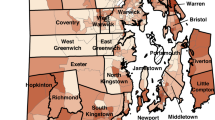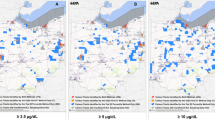Abstract
This study uses a new approach to assess the impact of different neighborhood characteristics on blood lead levels (BLLs) of black versus white children in metropolitan Detroit. Data were obtained from the Michigan Department of Community Health and the US Bureau of the Census American Community Survey. The Modified Darden-Kamel Composite Socioeconomic Index, bivariate regression, and the index of dissimilarity were used to compute neighborhood BLL unevenness by neighborhood characteristics. Neighborhoods with lower socioeconomic characteristics and high racial residential segregation predicted higher average childhood BLLs. This reveals a social spatial structure that will aid researchers/policymakers in better understanding disparities in childhood BLLs.


Similar content being viewed by others
Notes
*P ≤ 0.05; **P ≤ 0.01; ***P ≤ 0.001; ****P ≤ 0.0001
Additional bivariate regression analyses were performed to test if geometric mean BLLs were greater in neighborhoods of older occupied housing stock and less in neighborhoods of younger occupied housing stock for all race/ethnicity children in attempt to explain the residuals discussed above. The regression slope coefficient estimates for the percent year structure built in 1939 or before was 0.020**** (S.E. = 0.001), percent year structure built in 1979 or before 0.008**** (S.E. = 0.000), and percent year structure built in 2005 or later −0.027**** (S.E. = 0.005), validating that as housing stock increases in age, small but significant amounts of variation in BLLs increase across neighborhoods in the DMA. The y-intercept estimates from the analyses were 1.75, 1.57, and 2.12 with R-square values of 0.58, 0.21, and 0.03, respectively. These weak but interpretable patterns help in part to explain the imperfect associations of BLLs and SEP. Source: housing age stock was computed by the authors using the US Bureau of the Census, 2010 data.41
References
U.S. Environmental Protection Agency. Consumer Confidence Reports (CCR); Annual drinking water quality reports for Michigan. Washington, D.C.; 2016. Available at https://ofmpub.epa.gov/apex/safewater/f?p=136:103:::NO:RP,103:P103_STATE:MI. Accessed April 2 2016.
U.S. Agency for Toxic Substances and Disease Registry (ATSDR). ToxGuide for lead Pb CAS#7439-92-1. Atlanta, GA: U.S. Department of Health and Human Services: Public Health Service Agency for Toxic Substances and Disease Registry; 2007.
Schwartz J. Beyond LOEL’s, p values, and vote counting: methods for looking at the shapes and strengths of associations. NeuroToxicology. 1992; 14(2-3): 237–46.
Lanphear BP, Dietrich K, Auinger P, Cox C. Cognitive deficits associated with blood lead concentrations <10 microg/dL in U.S. children and adolescents. Public Health Rep. 2000; 115(6): 521–9.
Schnaas L, Rothenberg SJ, Perrom E, Martinez S, Hernandez C, Hernandez RM. Temporal pattern in the effect of postnatal blood lead level on intellectual development of young children. Neurotoxicol Teratol. 2000; 22(6): 805–10.
Lidsky TI, Schneider JS. Lead neurotoxicity in children: basic mechanisms and clinical correlates. Brain. 2003; 126(1): 5–19.
Canfield RL, Henderson CR, Cory-Slechta DA, et al. Intellectual impairment in children with blood lead concentrations below 10 μg per deciliter. New Engl J Med. 2003; 348(16): 1517–26.
Chiodo LM, Jacobson SW, Jacobson JL. Neurodevelopmental effects of postnatal lead exposure at very low levels. Neurotoxicol Teratol. 2004; 26(3): 359–71.
Téllez-Rojo MM, Bellinger DC, Arroyo-Quiroz C, et al. Longitudinal associations between blood lead concentrations lower than 10 μg/dL and neurobehavioral development in environmentally exposed children in Mexico City. Pediatrics. 2006; 118(2): 323–30.
Surkan PJ, Zhang A, Trachtenberg F, Daniel DB, McKinlay S, Bellinger DC. Neuropsychological function in children with blood lead levels <10 μg/dL. NeuroToxicology. 2007; 28(6): 1170–7.
Miranda ML, Kim D, Overstreet MA, Paul CJ, Hull AP, Morgan SP. The relationship between early childhood blood lead levels and performance on end-of-grade tests. Environ Health Persp. 2007; 115(8): 1242–7.
Centers for Disease Control and Prevention (CDC). CDC Response to Advisory Committee on Childhood Lead Poisoning Prevention Recommendations in ‘Low Level Lead Exposure Harms Children: a Renewed Call of Primary Prevention’. Atlanta, GA: The Department of Health and Human Services; 2012: (Publication No. 10 (26): 12).
Centers for Disease Control and Prevention (CDC). Low level exposure harms children: a renewed call for primary prevention. Report of the advisory committee on childhood lead poisoning prevention of the Centers for Disease Control and Prevention. Atlanta, GA; 2012. Available at http://www.cdc.gov/nceh/lead/acclpp/final_document_030712.pdf. Accessed 4 Jan 2016.
Centers for Disease Control and Prevention (CDC). CDC’s Childhood lead poisoning prevention program: what do parents need to know to protect their children? Atlanta, GA; 2012: Available at https://www.cdc.gov/nceh/lead/acclpp/blood_lead_levels.htm. Accessed 29 May 2015.
Bailey AJ, Sargent JD, Blake MK. A tale of two counties: childhood lead poisoning, industrialization, and abatement in New England. Econ Geogr. 1998; 74(s1): 96–111.
Guest AM, Almgren G, Hussey JM. The ecology of race and socioeconomic distress: infant and working-age mortality in Chicago. Demography. 1998; 35(1): 23–34.
Kawachi I. Income inequality and health. In: Berkman LF, Kawachi I, eds. Social epidemiology. New York, N.Y.: Oxford University Press; 2000: 76–94.
Krieger N, Chen JT, Waterman PD, Soobader M-J, Subramanian SV, Carson R. Geocoding and monitoring of U.S. socioeconomic inequalities in mortality and cancer incidence: does the choice of area-based measure and geographic level matter? The public health disparities geocoding project. Am J Epidemiol. 2002; 156(5): 471–82.
Acevedo-Garcia D, Lochner KA. Residential segregation and health. In: Kawachi I, Berkman LF, eds. Neighborhoods and health. New York, N.Y.: Oxford University Press; 2003: 265–87.
Subramanian SV, Chen JT, Rehkopf DH, Waterman PD, Krieger N. Racial disparities in context: a multilevel analysis of neighborhood variations in poverty and excess mortality among black populations in Massachusetts. Am J Public Health. 2005; 95(2): 260–5.
Grady SC, Darden JT. Spatial methods to study local racial residential segregation and infant health in Detroit, Michigan. Ann Assoc Am Geogr. 2012; 102(5): 922–31.
Moody H, Darden JT, Pigozzi BW. The racial gap in childhood blood lead levels related to socioeconomic position of residence in metropolitan Detroit. Sociol Race Ethnic. 2015; 2332649215608873: 1–19.
U.S. Department of Housing and Urban Development (HUD). Comprehensive and Workable Plan for the Abatement of Lead-Based Paint in Privately Owned Housing. Report to congress. Washington, D.C: HUD; 1990.
Bernard SM, McGeehin MA. Prevalence of blood lead levels ≥5 μg/dL among US children 1 to 5 years of age and socioeconomic and demographic factors associated with blood of lead levels 5 to 10 μg/dL, third national health and nutrition examination survey, 1988-1994. Pediatrics. 2003; 112(6): 1308–13.
Haley VB, Talbot TO. Geographic analysis of blood lead levels in New York State children born 1994-1997. Environ Health Persp. 2004; 112(15): 1577–82.
Centers for Disease Control and Prevention (CDC). Update: blood lead levels—United States, 1999–2002. MMWR Morb Mortal Wkly Rep. 2005; 54(20): 513–6.
Oyana TJ, Margai FM. Spatial patterns and health disparities in pediatric lead exposure in Chicago: characteristics and profiles of high-risk neighborhoods. Prof Geogr. 2010; 62(1): 46–65.
Krieger N, Chen JT, Waterman PD, Soobader M-J, Subramanian SV, Carson R. Choosing area based socioeconomic measures to monitor spatial inequalities in low birth weight and childhood lead poisoning: the public health disparities geocoding project. J Epidemiol Commun H. 2003; 57(3): 186–99.
Kaplowitz SA, Perlstadt H, Post LA. Comparing lead poisoning risk assessment methods: census block group characteristics vs. ZIP codes as predictors. Public Health Rep. 2010; 125(2): 234–45.
Vivier PM, Hauptman M, Weitzen SH, Bell S, Quilliam DN, Logan JR. The important health impact of where a child lives: neighborhood characteristics and the burden of lead poisoning. Matern Child Hlth J. 2010; 15(8): 1195–202.
Miranda ML, Dolinoy DC, Overstreet MA. Mapping for prevention: GIS models for directing childhood lead poisoning prevention programs. Environ Health Persp. 2002; 110(9): 947–53.
Centers for Disease Control and Prevention (CDC). CDC’s healthy homes/lead poisoning prevention program. Atlanta, GA: Content Source: National Center for Environmental Health; 2013. Available at: http://www.cdc.gov/nceh/information/healthy_homes_lead.htm. Accessed 14 Oct 2015.
Michigan Department of Health and Human Services (MDHHS). 2014 data report on childhood lead testing and elevated levels: Michigan. Lansing, MI: Division of Environmental Health Michigan Department of Health and Human Services; 2016. Available at: http://www.michigan.gov/documents/mdhhs/2014_Child_Lead_Testing_and_Elevated_Levels_Report_515233_7.pdf. Accessed 23 April 2016.
Tanner K, Kaffer N. State data confirms higher blood-lead levels in Flint kids. Detroit: The Detroit Free Press. September 29 2015.
Zhang NH, Baker W, Tufts M, Raymond RE, Salihu H, Elliot MR. Early childhood lead exposure and academic achievement: evidence from Detroit public schools, 2008-2010. Am J Public Health. 2013; 103(3): e72–7.
Farley R, Danzinger S, Holzer HJ. Detroit divided: a volume in the multi-city study of urban inequality. New York, NY: Russel Sage Foundation; 2000.
Darden JT, Rahbar M, Jezierski L, Li M, Velie E. The measurement of neighborhood socioeconomic characteristics and black and white residential segregation in metropolitan Detroit: implications for the study of social disparities in health. Ann Assoc Am Geogr. 2010; 100(1): 137–58.
State of Michigan. Final report of the task force to eliminate childhood lead poisoning. Lansing, MI; 2004. Available at http://www.michigan.gov/mdhhs/0,5885,7-339-73970_71692_8347-104658--,00.html. Accessed 10 Feb 2015.
Michigan Childhood Lead Poisoning Prevention and Control Commission. Plan to eliminate childhood lead poisoning in Michigan. Report presented in Lansing, MI; June 30 2007. Available at http://www.bridges4kids.org/leadreport2007.pdf. Accessed 20 Nov 2015.
Michigan Department of Community Health (MDCH). 2012 annual data report on blood lead levels of children in Michigan. Lansing, MI: Michigan Department of Community Health, State of Michigan; 2013. Available at https://www.michigan.gov/documents/mdch/2012AnnualDataReportOnBloodLeadLevels_419508_7.pdf. Accessed 2 March 2016.
U.S. Bureau of the Census. 2006-2010 5-year estimate census of population and housing (SF3): Michigan. Washington, D.C: Data User Services; 2010.
Krieger N. A century of census tracts: health and the body politic (1906–2006). J Urban Health: Bulletin of the New York Academy of Medicine. 2006; 83(3): 355–61.
Grady SC. Racial disparities in low birth weight and the contribution of residential segregation: a multilevel analysis. Soc Sci Med. 2006; 63(12): 3013–29.
Systat Software Inc. SYSTAT desktop release 13.1. Bangalore, India: Cranes Software International Ltd; 2009.
Department of Health and Human Services, Centers for Disease Control and Prevention. Fourth national report on human exposure to environmental chemicals: quality assurance of chemical measurements. Boca Raton, FL: The Department of Health and Human Services; 2009.
ESRI. ArcGIS desktop: release 10.1. Redlands, CA: Environmental Systems Research Institute; 2001.
Darden JT, Tabachneck AA. Algorithm 8: graphic and mathematical descriptions of inequality, dissimilarity, segregation, or concentration. Environ Plann A. 1980; 12(2): 227–34.
Darden JT, Hill RC, Thomas JM. Detroit: race and uneven development. Philadelphia, PA: Temple University Press; 1990.
Acknowledgments
We would like to express great appreciation to Dr. Sue Grady, Associate Professor of Geography at Michigan State University, for her place-based and public health outcomes expertise that provided invaluable detailed attention to the health nature of this research. We would also like to thank Dr. Robert Scott of the Michigan Department of Community Health not only for the blood lead level data but also for providing a wealth of ideas and technical information about childhood lead exposure.
Author information
Authors and Affiliations
Corresponding author
Rights and permissions
About this article
Cite this article
Moody, H.A., Darden, J.T. & Pigozzi, B.W. The Relationship of Neighborhood Socioeconomic Differences and Racial Residential Segregation to Childhood Blood Lead Levels in Metropolitan Detroit. J Urban Health 93, 820–839 (2016). https://doi.org/10.1007/s11524-016-0071-8
Published:
Issue Date:
DOI: https://doi.org/10.1007/s11524-016-0071-8




